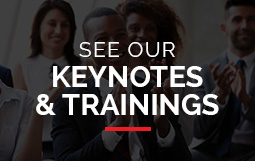It Starts Before You Start
When I coach business owners on mobile technology or social media use, I am constantly interrupted with questions and requests to go back to a certain page. That is what makes my workshops dynamic and engaging. The benefit to the audience is that these welcome comments and dialogue do not dissuade the delivery of my message. Ultimately, the audience still receives understandable and memorable information.
To deliver this type of presentation takes four actions that I implement before I stand up.
One Thing
There should be one key element people MUST leave with. If they can’t recite that one thing back to you in the end, they are not allowed to leave (just kidding). Spend time formulating your presentation around one key topic. If you do not know what that one central point is, your audience won’t know it either. Writer Jessica Stillman envisions a central point as a spine with other elements branching out from it. There should be a direct connection between anything presented and that key element.
 |
| Don’t Forget to Practice |
Who Are They
Before I begin any of my iPad / iPhone client events, I work the room. I walk around and talk to people about the device(s) they brought with them. I talk with them about their favorite apps and any frustrations they are experiencing. Why are they there? What do they want to learn? This action allows me to connect with them, and helps me focus my talk. I sometimes use their name during the presentation to draw them in and make them feel included. To make this tactic successful, I have to…
Arrive Early
Everyone has had something go wrong during a presentation. The bulb goes out on the projector. The laptop stops working. The television falls off the wall (yeah, that happened to me). If you arrive early, you can test the equipment, meet the audience (see number 2 above) and get a drink (of water). Most of my clients are amazed that I arrive before they do. As my Boy Scout Troop Leader Mr. Andrews taught me, “It is better to arrive 1 hour early, than 1 minute late.”
Practice
Steve Jobs practiced. Dr. Martin Luther King, Jr. practiced. Even I practice. When I am teaching business apps to business owners, I know the 12 – 14 apps I am going to demonstrate before I start talking. I know how they will look and perform on the screen. I know the pros and cons. If my iPad stops working, I have a back up. I even have funny stories to share while changing out the device. All of this seems natural to my audience, while I am secretly sweating with fear on the inside. I never miss a beat because I practiced.
These four pre-presentation tips will help your audience understand and remember your topic of discussion. Everything you do is about increasing the audience reception of information. If they are not happy, you won’t be happy.
Scientifically Speaking, of course.
Next Week: $19 billion Worth of Eyes



